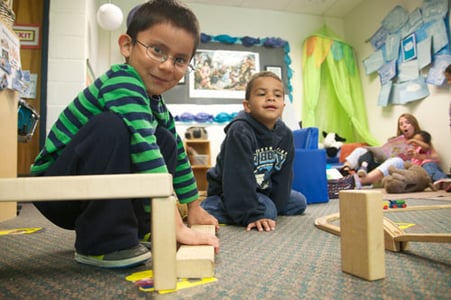
We’re heading down an unfamiliar sidewalk with a multitude of other pedestrians. Never having been in this part of the city, we reach the four-way intersection with some trepidation. The tangle of roadway, traffic lights, and swift-moving vehicles is intimidating. Should we even cross? It doesn’t seem to be the best idea to put our heads down and blindly dodge and dart across the roadway as we see others attempting. And then, voilà, a crosswalk! A place of authority for those on foot. Now with a clear sense of direction and purpose, we look left, right, left and then step out onto the street. Like magic, cars stop and wait while we make our way across, able to now move rapidly toward our destination.
In this age of the QRIS, I cannot help but liken its many attendant parts, often necessarily overlaid onto existing systems, much like the knot of roadway described above. Without a way to disentangle one assessment from another, or one teacher qualification requirement from another, we might be left with feelings of frustration and possibly disenfranchisement. What does it mean to add more requirements? How does what I have already learned, adopted, and maximized play into this new system? A crosswalk of seemingly competing frameworks, assessments, and requirements can lay the path toward understanding where existing systems intersect with, as well as deviate from, the new. A crosswalk can serve as map to increase efficiency, understanding, and buy-in.
We at Teachstone® have long seen the value in, and requests for, crosswalks of all kinds. One in particular involves the overlap between the CLASS™ and the Danielson framework. Given the wide adoption of Danielson with its foundational value and application in coaching, professional development, and teacher evaluation processes, it makes sense to understand this framework in relation to the CLASS tool, often built into a QRIS as both observation assessment and professional development. Both frameworks have at their core the development of encouraging and developing self-reflective practice. Download our crosswalk (PDF): Classroom Assessment Scoring System (CLASS) and Danielson's Framework for Teaching Crosswalk. This latest iteration was completed by my colleague Joe Pierce, Client Implementation Manager.
As you consider your QRIS, how might a crosswalk benefit progression and efficiency in:
- Teaching and learning
- Family involvement
- Staff education and training
- Program leadership
Stop back again for more details on a CLASS crosswalk with California’s Early Childhood Educator (ECE) Competencies and the California Preschool Learning Foundations. Tell us, too, which crosswalks you have completed and/or which would be of most value.
Together we will map the QRIS roadway for greater understanding, application, and success!

